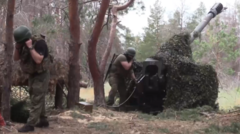In recent weeks, Russia has escalated its drone and missile attacks on Ukraine, attempting to solidify military gains while claiming control over significant territories. According to the open-source monitoring site DeepState, Russian forces have captured approximately 556 square kilometers (215 square miles), marking the largest land acquisition the country has seen this year - a space roughly four times larger than Liverpool and almost equivalent to that of Chicago.
The primary objective for Russia is to sever supply lines utilized by Ukrainian troops in the eastern regions and establish a buffer zone within Ukraine's boundaries. However, their advancements appear to be sluggish; continuing at this rate could mean years before any substantial progress is made in capturing more territory.
Most Russian military operations have focused on three critical locales: the Sumy region in northeastern Ukraine, the strategic eastern cities of Pokrovsk and Kostyantynivka, and a third locus positioned west of Pokrovsk. While Russian troops advanced approximately 10-12 kilometers (6-7.5 miles) into Sumy recently, they now confront significant resistance, causing their offensive to stall.
President Vladimir Putin asserts that a buffer zone is essential to safeguard Russian territory, especially after Ukrainian forces previously occupied Kursk last summer. Russian troops have crossed into Ukrainian territory but have quickly faced challenges in small border fights, with little sign of a broader offensive without reinforcements.
Military observers surmise that Russia's operations are designed to compel Ukraine to divide its resources along the expansive 1,200-kilometer frontline, subsequently weakening its hold on essential areas like Pokrovsk. This specific location has been a target for Moscow for over two years, with an estimated 111,000 Russian forces currently focused there.
Reports indicate that instead of launching large attacks, Russian forces resort to smaller, incremental advances characterized by infantry tactics, which aim to exhaust Ukrainian resources. This "creeping offensive" bears a staggering toll, with Ukrainian officials estimating Russian casualties at over 1,000 soldiers daily.
Plans for tactical encirclement aim to surround Ukrainian forces in Pokrovsk and Kostyantynivka, driving them to retreat. Current Russian infiltration between these cities is sluggish, with earlier efforts to gain ground from other directions having stalled.
Recently, Russians achieved significant gains further west from Pokrovsk in the Novopavlivske region, permitting rapid advances of up to 10 kilometers per day. However, Ukrainian officials challenge claims regarding extensive Russian control in nearby Dnipropetrovsk, asserting that small incursions have been swiftly countered.
Despite the setbacks, Ukraine's forces are experiencing mounting pressure as relentless drone assaults disrupt critical supply lines. "Routes we relied on a couple of months ago are no longer accessible," Staff Sgt Viktor Pyasetskyi from Ukraine’s 93rd brigade shared. This situation complicates logistics for supplying food, munitions, and troop rotations, exacerbated by drones' capability to reach previously secure areas unexpectedly.
Efforts from Russian forces extend beyond military objectives, with psychological warfare aimed at demoralizing Ukrainian resistance and undermining public confidence. Meanwhile, the increasing chaos and civilian casualties from drone attacks continue to haunt the population in impacted regions.
The primary objective for Russia is to sever supply lines utilized by Ukrainian troops in the eastern regions and establish a buffer zone within Ukraine's boundaries. However, their advancements appear to be sluggish; continuing at this rate could mean years before any substantial progress is made in capturing more territory.
Most Russian military operations have focused on three critical locales: the Sumy region in northeastern Ukraine, the strategic eastern cities of Pokrovsk and Kostyantynivka, and a third locus positioned west of Pokrovsk. While Russian troops advanced approximately 10-12 kilometers (6-7.5 miles) into Sumy recently, they now confront significant resistance, causing their offensive to stall.
President Vladimir Putin asserts that a buffer zone is essential to safeguard Russian territory, especially after Ukrainian forces previously occupied Kursk last summer. Russian troops have crossed into Ukrainian territory but have quickly faced challenges in small border fights, with little sign of a broader offensive without reinforcements.
Military observers surmise that Russia's operations are designed to compel Ukraine to divide its resources along the expansive 1,200-kilometer frontline, subsequently weakening its hold on essential areas like Pokrovsk. This specific location has been a target for Moscow for over two years, with an estimated 111,000 Russian forces currently focused there.
Reports indicate that instead of launching large attacks, Russian forces resort to smaller, incremental advances characterized by infantry tactics, which aim to exhaust Ukrainian resources. This "creeping offensive" bears a staggering toll, with Ukrainian officials estimating Russian casualties at over 1,000 soldiers daily.
Plans for tactical encirclement aim to surround Ukrainian forces in Pokrovsk and Kostyantynivka, driving them to retreat. Current Russian infiltration between these cities is sluggish, with earlier efforts to gain ground from other directions having stalled.
Recently, Russians achieved significant gains further west from Pokrovsk in the Novopavlivske region, permitting rapid advances of up to 10 kilometers per day. However, Ukrainian officials challenge claims regarding extensive Russian control in nearby Dnipropetrovsk, asserting that small incursions have been swiftly countered.
Despite the setbacks, Ukraine's forces are experiencing mounting pressure as relentless drone assaults disrupt critical supply lines. "Routes we relied on a couple of months ago are no longer accessible," Staff Sgt Viktor Pyasetskyi from Ukraine’s 93rd brigade shared. This situation complicates logistics for supplying food, munitions, and troop rotations, exacerbated by drones' capability to reach previously secure areas unexpectedly.
Efforts from Russian forces extend beyond military objectives, with psychological warfare aimed at demoralizing Ukrainian resistance and undermining public confidence. Meanwhile, the increasing chaos and civilian casualties from drone attacks continue to haunt the population in impacted regions.

















